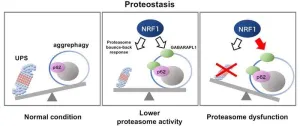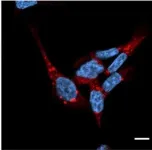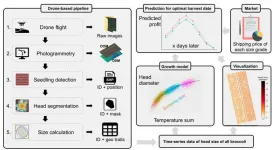Study reveals novel therapeutic target to eliminate unwanted and misfolded proteins
A recent discovery unearths the hidden mechanism of “aggrephagy," with major implications for degenerative protein diseases
2023-10-04
(Press-News.org)
Biological cells contain in-built "housekeeping" mechanisms for taking care of damaged cellular structures. This includes the ubiquitin‒proteasome system (UPS), which selectively tags unwanted proteins with the ubiquitin molecule, and then clears them. When the UPS mechanism fails, cells activate a compensatory protein clearance process called "aggrephagy," in which protein aggregates are degraded by the cell in a controlled manner. However, thus far, the mechanism behind aggrephagy has been unknown.
Now, a landmark paper published on 1 September 2023 in Volume 13, Issue 1 of Scientific Reports, reveals the underlying mechanism. “Our study demonstrates that the activation of aggrephagy is induced by the transcription factor NRF1 (NFE2L1) in response to proteasome dysfunction,” explains Atsushi Hatanaka, graduate student at Doshisha University, Japan, who is the first author of the study. The research team also included Sota Nakada and Akira Kobayashi, both from the Laboratory for Genetic Code, Graduate School of Life and Medical Sciences, Doshisha University.
NRF1, a protein involved in the transcription of DNA to RNA, plays a key role in the balance and regulation of proteins. It upregulates proteasome genes when the proteasome is damaged. As a part of the study, the team first used small interfering RNA (siRNA) to reduce the activity of the NRF1 synthesis gene in a cellular model. They then used the inhibitor MG132 to block proteasome-mediated protein recycling. These treatments led to the accumulation of undesired proteins in the cellular model, indicating that the absence of NRF1 effectively inhibited aggrephagy activation, which is otherwise typically prevalent in a cell.
The researchers then examined the effect of proteasome inhibition on genes that were direct targets of NRF1. During the course of experiments, the team noticed that in response to proteasomal failure, NRF1 caused an increase in the levels of the autophagy-related genes p62 and GABARAPL1. The elevated levels of the corresponding proteins p62 and GABARAPL1 resulted in the removal of proteins that were tagged for removal by the housekeeping protein ubiquitin. In other words, NRF1 was found to trigger the process of aggrephagy via p62 and GABARAPL1 as a direct physiological response to proteasomal failure.
Next, the team also discovered that the presence of NRF1 was necessary for the formation of p62-positive puncta—tiny round cellular structures loaded with large amounts of the protein p62. Moreover, it became evident that the colocalization (physical proximity) of the proteins p62, ULK1, and TBK1 was necessary for the activation of p62. This activation is considered to be the direct result of phosphorylation—the addition of phosphate groups to proteins. A series of experiments revealed that the phosphorylation of p62 was facilitated by NRF1. The phosphorylated p62 then contributed to the process of aggrephagy. As mentioned before, a similar increase in aggrephagy was also observed after the NRF1-mediated increase in the levels of the protein GABARAPL1.
Explaining the novelty of the research, Mr. Hatanaka says, "Although NRF1 has been previously shown to upregulate proteasome genes when the proteasome is dysfunctional, our genome-wide transcriptome analyses showed that NRF1 directly upregulates autophagy-related genes p62 and GABARAPL1.”
These findings pave the way toward the development of novel therapeutics for degenerative diseases such as Alzheimer's disease, Parkinson's disease, and dementia with Lewy bodies—all of which are caused by the accumulation of misfolded proteins.
About Atsushi Hatanaka from Doshisha University, Japan
Atsushi Hatanaka is currently pursuing his Ph.D. from Doshisha University’s Graduate School of Life and Medical Sciences. He has published his research in more than seven peer-reviewed journals and his work has received more than 100 global citations so far. Atsushi has primarily conducted research in the area of molecular biology.
Funding information
This work was supported in part by grants-in-aid (18J20672 (AH), 19K22826 (AK), 20H04135 (AK), 21K19743 (AK), 22H04659 (AK), 19K07650 (TW), 22K07219 (TW) and 22H03515 (TT)) from the Ministry of Education, Culture, Sports, Science and Technology and the Mitsubishi Foundation (AK).
Media contact:
Organization for Research Initiatives & Development
Doshisha University
Kyotanabe, Kyoto 610-0394, JAPAN
E-mail:jt-ura@mail.doshisha.ac.jp
END
[Attachments] See images for this press release:


ELSE PRESS RELEASES FROM THIS DATE:
2023-10-04
Residing in a more walkable neighborhood protects against the risk of overall obesity-related cancers in women, specifically postmenopausal breast cancer, but also ovarian cancer, endometrial cancer, and multiple myeloma, according to a new study by Columbia University Mailman School of Public Health and NYU Grossman School of Medicine. Obesity has been linked to increased risk for 13 types of cancer in women, and physical activity, independent of body size, lowers risk for some of these cancers. Neighborhood walkability ...
2023-10-04
Australia’s emerging pattern of severe mega bushfires and heavy rainfall may be driving platypuses from their homes, a new study by University of Melbourne researchers has shown.
Analysis of platypus DNA in rivers and creek water samples collected before and after the Black Summer 2019-2020 megafires suggest Australia’s beloved semi-aquatic monotremes might be abandoning severely bushfire-affected areas for up to 18 months after a fire, especially if heavy rainfall has followed the fire.
The study uses the recent technique of environmental DNA sampling, where animal DNA is collected from water, soil, air, or snow ...
2023-10-04
A research group has created a new model to calculate the probability of the occurrence of localized clusters caused by novel coronavirus infections. Led by Shingo Iwami at Nagoya University with collaborators in the United Kingdom and South Korea model, they revealed that screening of infected persons by antigen testing is effective in significantly reducing the probability of cluster occurrence. However, their findings also suggest that it is not sufficient to prevent clusters caused by highly infectious mutant strains, such as Omicron.
With the availability of COVID-19 vaccines and population immunity, countries around the world are seeking to ...
2023-10-04
For reasons of food security and economic incentive, farmers continuously seek to maximize their marketable crop yields. As plants grow inconsistently, at the time of harvesting, there will inevitably be variations in quality and size of individual crops. Finding the optimal time to harvest is therefore a priority for farmers. A new approach making heavy use of drones and artificial intelligence demonstrably improves this estimation by carefully and accurately analyzing individual crops to assess their likely growth characteristics.
Some optimistic science fiction stories talk about a post-scarcity future, where human needs are catered for and hard labor ...
2023-10-04
A new study published today, analysing wastewater samples from several aged care and retirement homes in Adelaide, has uncovered worrying signs of antimicrobial resistance (AMR) in at least one facility.
High levels of bacterial resistance against three common antibiotics – ceftazidime, cefepime and ciprofloxacin – were identified in one aged care residential home. A second facility recorded above average levels of antimicrobial resistance to gentamicin, putting residents’ health at risk.
The listed antibiotics are used to treat a variety of bacterial infections, including pneumonia, ...
2023-10-04
Parrots are exceptional talkers. They can learn new sounds during their entire lives, amassing an almost unlimited vocal repertoire. At the same time, parrots produce calls so they can be individually recognized by members of their flock—raising the question of how their calls can be very variable while also uniquely identifiable. A study on monk parakeets conducted by the Max Planck Institute of Animal Behavior and Museu de Ciències Naturals de Barcelona might have the answer: individuals have a unique tone of voice, known as a voice print, similar to that in humans. This finding in a wild parrot raises the possibility that a voice print ...
2023-10-04
Researchers from The University of Queensland and The Alfred hospital in Melbourne have identified gene variants which may contribute to people being at higher risk for nodular melanoma.
Dr Mitchell Stark from UQ’s Frazer Institute said nodular melanoma only accounts for around 14 per cent of invasive melanoma cases, but the aggressive subtype is the largest contributor to melanoma deaths.
“Melanoma is highly curable by surgery when diagnosed early, but nodular melanoma is often detected ...
2023-10-04
Public health initiatives to understand and tackle these inequalities should be prioritised, say the researchers.
The aortic valve keeps blood flowing from the heart's lower left chamber (left ventricle) to the aorta—the main artery bringing blood from the heart to the body. Aortic stenosis occurs when the aortic valve narrows as a result of calcium build-up, impeding normal blood flow. This causes shortness of breath, light headedness, and chest pain (angina).
Aortic valve replacement (AVR) not only relieves these symptoms, but increases life expectancy, and improves quality of life, say the researchers, adding that up to 1 in 4 of those with severe or very severe aortic stenosis ...
2023-10-04
Information on clinical complications is often missing, while key information on the factors behind medical decision-making, the effectiveness of the lethal drugs used, and the extent of palliative care support isn’t even collected, reveals the review.
Physician assisted suicide as it’s formally known has been legal in the US state of Oregon since 1997 under the Death with Dignity Act.
The legislation allows terminally ill residents over the age of 18 to hasten their death by taking lethal drugs prescribed by a doctor, providing they are capable of making and communicating healthcare ...
2023-10-04
A device has been created that could carry out Clinical Breast Examinations (CBE).
The manipulator, designed by a team at the University of Bristol and based at the Bristol Robotics Laboratory, is able to apply very specific forces over a range similar to forces used by human examiners and can detect lumps using sensor technology at larger depths than before.
This could revolutionise how women monitor their breast health by giving them access to safe electronic CBEs, located in easily accessible places, such as pharmacies and health centres, which provide accurate results.
Precision, repeatability and ...
LAST 30 PRESS RELEASES:
[Press-News.org] Study reveals novel therapeutic target to eliminate unwanted and misfolded proteins
A recent discovery unearths the hidden mechanism of “aggrephagy," with major implications for degenerative protein diseases





